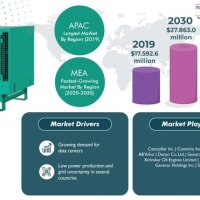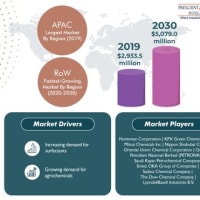Rapid advancements in the global textile industry, on account of the presence of favourable government policies and regulations for textile production in many countries, are propelling the demand for plastisols across the world. For instance, according to the data published by Indonesia-Investments, the Indonesian government intends to increase the value of the exported garments and textiles to as high as $75 billion by 2030. Similarly, the Indian government built 13 textile parks in the country in 2014, as per the Scheme for Integrated Textile Parks, for lending greater financial support to the textile entrepreneurs of the country.
The growth of the textile industry is also creating huge demand for printed fabrics and textiles such as printed sweatshirts, cushions, bed covers, jeans, printed t-shirts, and various other kinds of clothing and apparels all over the world. In these textiles, plastic inks are extensively used for coating and inking purposes, owing to their opaqueness, excellent performance qualities on fabrics, and high cost-effectiveness. In addition to this, customers all around the world are increasingly preferring colored fabrics and patterns, which is further pushing the sales of plastisols in many countries.
Driven by the above-mentioned factors, the revenue generated from the worldwide sales of plastisols is predicted to rise from $26,267.2 million to $40,464.8 million from 2017 to 2023. The global plastisols market is expected to exhibit a CAGR of 7.5% during the forecast period (2018–2023). Plastisols are basically suspension mixtures of polyvinyl chloride (PVC) plasticizers and materials. These substances are not water-soluble and have numerous favorable characteristics such as high chemical resistance, corrosion-resistance, and fire resistance, which make them highly sought-after in applications such as screen printing, coatings, adhesives and sealants, and moldings.
Get a sample copy of this report: https://www.psmarketresearch.com/market-analysis/plastisols-market/report-sample
Plastisols are widely used in textile screen printing, adhesives and sealants, coatings, and moldings. Out of these applications, the textile screen printing applications are predicted to register the fastest growth in the utilization of plastisols during the forecast period. This is mainly ascribed to the wide-scale incorporation of textile screen printing in apparels and clothing all around the globe. Plastisols are majorly used in construction, automotive, textile, recreational, and medical industries. Amongst these, the textile industry is expected to record the highest growth in the usage of plastisols during the forecast period.
One of the major trends currently being witnessed in the plastisols market is the rising usage of plastisols in various industries such as construction, automotive, and textile. This is mainly attributed to the numerous advantages of plastisols over the traditionally used water-based inks such as excellent anti-corrosive properties, higher thermal conductivity, and superior performance when exposed to reactive chemicals and high temperatures. In addition to this, plastisols do not dry up when exposed to air and therefore, they can be used for multiple purposes.
On the basis of global analysis, the Asia-Pacific (APAC) region is predicted to observe the fastest growth in the utilization of plastisols during the forecast period. The main factors responsible for the surging usage of plastisols in this region are the high plastisol production capacities of the plastisol manufacturing companies and the high economic stability of the various countries in the region. Additionally, rapid technological advancements in plastisols and the rising need for the material in the transportation and textile industries are contributing toward its growing demand in the region.
Hence, it is clear that the sales of plastisols will shoot-up across the world over the next few years, because their rising requirement in the textile industry and their increasing utilization in various industrial applications.
The growth of the textile industry is also creating huge demand for printed fabrics and textiles such as printed sweatshirts, cushions, bed covers, jeans, printed t-shirts, and various other kinds of clothing and apparels all over the world. In these textiles, plastic inks are extensively used for coating and inking purposes, owing to their opaqueness, excellent performance qualities on fabrics, and high cost-effectiveness. In addition to this, customers all around the world are increasingly preferring colored fabrics and patterns, which is further pushing the sales of plastisols in many countries.
Driven by the above-mentioned factors, the revenue generated from the worldwide sales of plastisols is predicted to rise from $26,267.2 million to $40,464.8 million from 2017 to 2023. The global plastisols market is expected to exhibit a CAGR of 7.5% during the forecast period (2018–2023). Plastisols are basically suspension mixtures of polyvinyl chloride (PVC) plasticizers and materials. These substances are not water-soluble and have numerous favorable characteristics such as high chemical resistance, corrosion-resistance, and fire resistance, which make them highly sought-after in applications such as screen printing, coatings, adhesives and sealants, and moldings.
Get a sample copy of this report: https://www.psmarketresearch.com/market-analysis/plastisols-market/report-sample
Plastisols are widely used in textile screen printing, adhesives and sealants, coatings, and moldings. Out of these applications, the textile screen printing applications are predicted to register the fastest growth in the utilization of plastisols during the forecast period. This is mainly ascribed to the wide-scale incorporation of textile screen printing in apparels and clothing all around the globe. Plastisols are majorly used in construction, automotive, textile, recreational, and medical industries. Amongst these, the textile industry is expected to record the highest growth in the usage of plastisols during the forecast period.
One of the major trends currently being witnessed in the plastisols market is the rising usage of plastisols in various industries such as construction, automotive, and textile. This is mainly attributed to the numerous advantages of plastisols over the traditionally used water-based inks such as excellent anti-corrosive properties, higher thermal conductivity, and superior performance when exposed to reactive chemicals and high temperatures. In addition to this, plastisols do not dry up when exposed to air and therefore, they can be used for multiple purposes.
On the basis of global analysis, the Asia-Pacific (APAC) region is predicted to observe the fastest growth in the utilization of plastisols during the forecast period. The main factors responsible for the surging usage of plastisols in this region are the high plastisol production capacities of the plastisol manufacturing companies and the high economic stability of the various countries in the region. Additionally, rapid technological advancements in plastisols and the rising need for the material in the transportation and textile industries are contributing toward its growing demand in the region.
Hence, it is clear that the sales of plastisols will shoot-up across the world over the next few years, because their rising requirement in the textile industry and their increasing utilization in various industrial applications.




















※コメント投稿者のブログIDはブログ作成者のみに通知されます